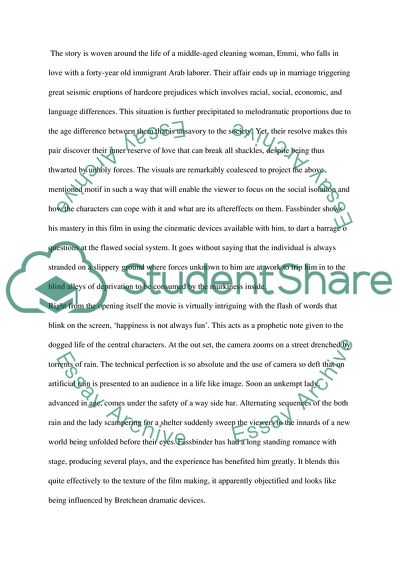Cite this document
(Ali: Fear Eats The Soul Essay Example | Topics and Well Written Essays - 1500 words, n.d.)
Ali: Fear Eats The Soul Essay Example | Topics and Well Written Essays - 1500 words. Retrieved from https://studentshare.org/visual-arts-film-studies/1705580-examine-the-filmic-means-used-by-fassbinder-to-portray-social-isolation-and-its-consequences-in-fear-eats-the-soulconsider-the-ways-in-which-fassbinder-uses-p
Ali: Fear Eats The Soul Essay Example | Topics and Well Written Essays - 1500 words. Retrieved from https://studentshare.org/visual-arts-film-studies/1705580-examine-the-filmic-means-used-by-fassbinder-to-portray-social-isolation-and-its-consequences-in-fear-eats-the-soulconsider-the-ways-in-which-fassbinder-uses-p
(Ali: Fear Eats The Soul Essay Example | Topics and Well Written Essays - 1500 Words)
Ali: Fear Eats The Soul Essay Example | Topics and Well Written Essays - 1500 Words. https://studentshare.org/visual-arts-film-studies/1705580-examine-the-filmic-means-used-by-fassbinder-to-portray-social-isolation-and-its-consequences-in-fear-eats-the-soulconsider-the-ways-in-which-fassbinder-uses-p.
Ali: Fear Eats The Soul Essay Example | Topics and Well Written Essays - 1500 Words. https://studentshare.org/visual-arts-film-studies/1705580-examine-the-filmic-means-used-by-fassbinder-to-portray-social-isolation-and-its-consequences-in-fear-eats-the-soulconsider-the-ways-in-which-fassbinder-uses-p.
“Ali: Fear Eats The Soul Essay Example | Topics and Well Written Essays - 1500 Words”, n.d. https://studentshare.org/visual-arts-film-studies/1705580-examine-the-filmic-means-used-by-fassbinder-to-portray-social-isolation-and-its-consequences-in-fear-eats-the-soulconsider-the-ways-in-which-fassbinder-uses-p.


